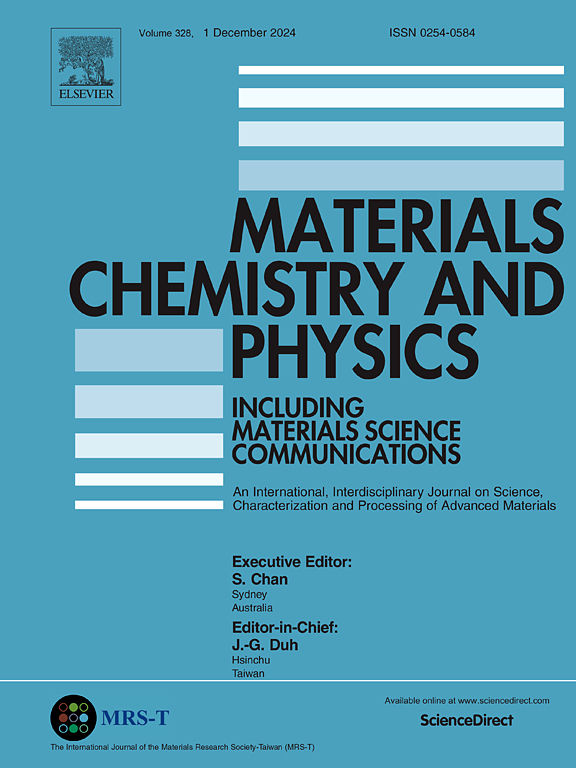环保工艺的持久抗菌含银不锈钢与均匀分散的纳米颗粒
IF 4.7
3区 材料科学
Q2 MATERIALS SCIENCE, MULTIDISCIPLINARY
引用次数: 0
摘要
生物医用不锈钢表面的细菌粘附和生物膜形成仍然是一个重大挑战,经常导致植入物相关感染和设备故障。传统的抗菌涂料在持久抗菌能力和均匀性方面存在局限性。为了解决这些问题,本研究采用一种新的化学镀银方法开发了一种可持续的含银抗菌不锈钢(316LSS)。采用聚乙烯亚胺-戊二醛(PEI-co-GA/Ag)复合材料作为锚定剂增强银的粘附性,酒石酸钾钠作为绿色还原剂实现银纳米颗粒(AgNP)的均匀沉积。考察了三种还原温度(30,40和50℃)对还原效果的影响。在40°C和50°C制备的涂层表现出改善的AgNP分散(粒径约80-100 nm),强附着力(约2 wt%银)和优异的抗菌活性(r值>;1.92)。烧结后分析证实,合金中仍有1.7% - 2.2%的银均匀分布。经50℃镀后的样品抗菌效果最高,超过了JIS Z 2810 (ISO 22196/JIS Z 2801)的检测限。AgNPs在磨损后也表现出很强的保留力,表明其具有长期的功能。这种环保策略为制造用于医疗应用的抗菌316LSS提供了一条有前途的途径。本文章由计算机程序翻译,如有差异,请以英文原文为准。

Eco-friendly process of durable antimicrobial silver-containing stainless steel with uniform dispersion of nanoparticles
Bacterial adhesion and biofilm formation on biomedical stainless steel surfaces remain significant challenges, often leading to implant-related infections and device failure. Conventional antibacterial coatings face limitations in long-lasting antibacterial ability and uniformity. To address these issues, this study develops a sustainable silver-containing antibacterial stainless steel (316LSS) using a novel electroless silver plating method. Polyethyleneimine-glutaraldehyde (PEI-co-GA/Ag) composites were employed as anchoring agents to enhance silver adhesion, while potassium sodium tartrate served as a green reducing agent to achieve uniform silver nanoparticle (AgNP) deposition. The effects of three reduction temperatures (30, 40, and 50 °C) were investigated. Coatings prepared at 40 °C and 50 °C exhibited improved AgNP dispersion (particle size ∼80–100 nm), strong adhesion (∼2 wt% silver), and excellent antibacterial activity (R-value >1.92). Post-sintering analysis confirmed that 1.7 %–2.2 % silver remained evenly distributed within the alloy. The sample plated at 50 °C showed the highest antibacterial efficacy, surpassing the detectable limit in JIS Z 2810 (ISO 22196/JIS Z 2801) tests. AgNPs also demonstrated strong retention after abrasion, indicating long-term functionality. This eco-friendly strategy offers a promising route for fabricating antibacterial 316LSS for medical applications.
求助全文
通过发布文献求助,成功后即可免费获取论文全文。
去求助
来源期刊

Materials Chemistry and Physics
工程技术-材料科学:综合
CiteScore
8.70
自引率
4.30%
发文量
1515
审稿时长
69 days
期刊介绍:
Materials Chemistry and Physics is devoted to short communications, full-length research papers and feature articles on interrelationships among structure, properties, processing and performance of materials. The Editors welcome manuscripts on thin films, surface and interface science, materials degradation and reliability, metallurgy, semiconductors and optoelectronic materials, fine ceramics, magnetics, superconductors, specialty polymers, nano-materials and composite materials.
 求助内容:
求助内容: 应助结果提醒方式:
应助结果提醒方式:


